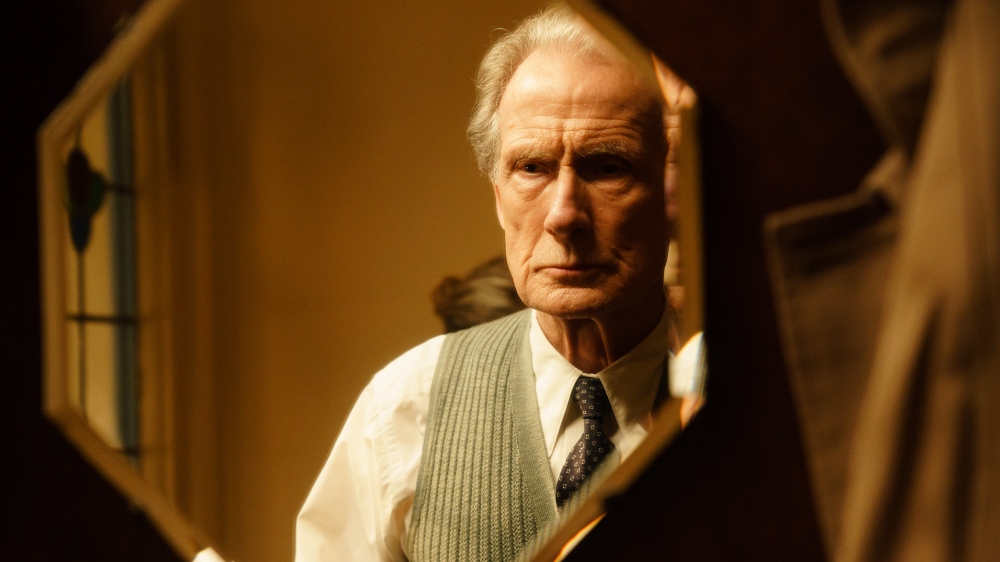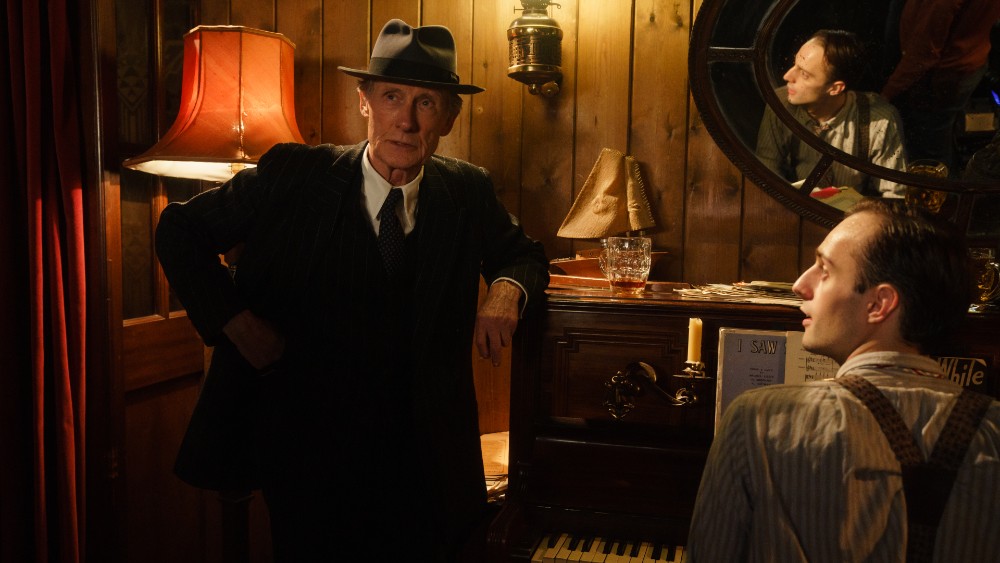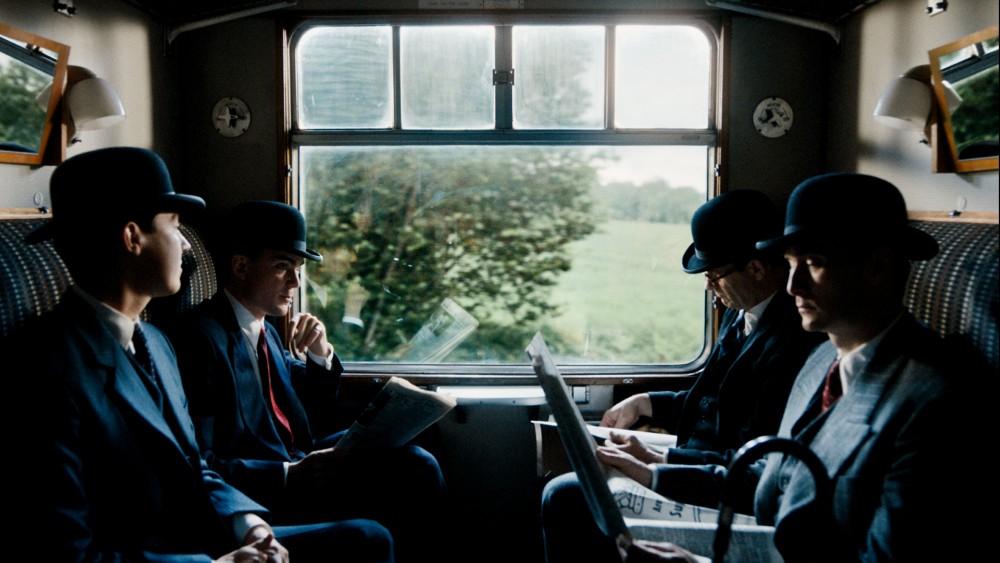What would you do with your life if you were given a finite number to your existence, with perhaps only months to live? The question is posed by Living, a reimagining of Akira Kurosawa‘s 1952 film Ikiru that transposes the setting to 1953 London.
Bill Nighy delivers one of his very best performances as an ordinary man leading a mundane life — a veteran civil servant caught up in a bureaucratic existence — when he is given shattering news that forces him to take stock, setting him on an odyssey to create a legacy for the next generation.
Directed by Oliver Hermanus, Living is contemplative, sometimes melancholy, but hopeful in its tone, which called for the musical touch of award-winning French pianist, composer, and recording artist Emilie Levienaise-Farrouch (Rocks, Censor, The Forgotten Battle), who was tasked with creating a score that would reflect those emotions. Her musical journey first began at university, where she scored student short films, collaborated with visual artists, and created sound installations. As a composer for Living, her goal, at times, was to convey grief and sadness without tugging too hard at your heartstrings.
Below the Line recently spoke with Emilie Levienaise-Farrouch via Zoom from her music studio in London. She talked about how she got involved with the project, which was shot within walking distance of where she lives. Emilie also discussed the inspirations behind the instrumentation used to evoke what the characters were thinking and feeling, the use of vocals to illustrate the film’s recurring themes, and how surprised she was that her score moved some audiences to tears.

Below the Line: I’m curious how the project made its way to you, so how did you first get involved with Living?
Emilie Levienaise-Farrouch: I think it’s the classic case of being approached via my agent to check availabilities, and then I asked to receive the script to prepare for a meeting with Oliver. I loved The Remains of the Day, both the books and the film adaptation. (The script was written by Kazuo Ishiguro, who also wrote the novel). So as soon as I was told who the people were involved in making this film, I was very keen on having a meeting with Oliver. It was just such a good screenplay, and I could just hear Bill Nighy in that part. I prepared for it, and the meeting with Oliver took place at the production office, which was set at County Hall, which is actually where the film is set and filmed.
BTL: Since you live in London, was the location near your home?
Levienaise-Farrouch: It’s really near my house in London, and so I walked to the meeting, and the production office had every square inch of wall covered in still photography and research. Everything had been laid out, from the lighting to the framing. Everything was so thoroughly researched by Oliver, and I suspect [Cinematographer] Jamie Ramsay as well. Even before we started speaking, I was like, “Wow, someone is very passionate, very invested, very thorough, and has such a clear vision of what he wants to achieve.” Then I just really focused to make sure I nailed that interview, which apparently I did.

BTL: How did you prepare musically, did you have any ideas ahead of time for this audition?
Levienaise-Farrouch: I did have some initial thoughts, which isn’t always the case. Sometimes I have a strong reaction to the project, but I don’t necessarily hear it already. But on this one, there just seemed to be some. “Not too much fun, and game rather like church,” says a line of dialogue early in the film. And for some reason, that kind of triggered thinking about the use of vocals, but not necessarily in a choir or religious way, because it’s such a recurring theme of the difficulty of communicating, the difficulty of integrating into a community, but also of people working together towards achieving a goal. For some reason, it always felt like voices had something in common in that vein because it’s humans coming together to do the most basic thing and one of the most rewarding and ancient things, which is joining our voices and singing together. So that always felt like a good approach. I mentioned to Oliver early on the idea of having two separate pallets: one that is more community-oriented and one that is more Williams-oriented (Bill Nighy). As we evolve, we kind of start meshing them together a little bit more.
BTL: How did you evoke these emotions with the instruments?
Levienaise-Farrouch: It’s a tricky one because it’s hard to put into words for me. It’s not fully instinctual because obviously there’s a lot of training, but it is kind of instinctual, I think. It’s more compositional technique. So the short repetitive pattern is really rhythmical for me and has this symbol of going through the motions and being active and busy while the strings, the string quartet, or small string ensemble in the tent (the burlesque in Brighton) scene: it’s not just the sound of an instrument but also the way that I ask the player to perform, which is using slightly too much bow pressure to have this kind of grit and intensity. The piano, I suppose, has a clarity to its sound, and it’s also an instrument that I’m very familiar with. So in terms of the pub scene with Aimee Lou Wood and Bill, it has to kind of really accompany a lot of complex emotional journeys and realizations, and I guess the piano in this sense, with the clarity of its sounds, echoes the clarity of William’s mind. He understands what his emotions are, so it made more sense to have an instrument that has a clearer sound. But also, it is a long piece of music, and I just felt like if I used the piano for this one, I would be able to achieve with just one instrument a level of detail and precision. Because the piano is polyphonic, you can experiment with colors and harmonies while maintaining the intimacy of a solo instrument. So that felt really right for that moment in particular.

BTL: That’s interesting. What about the moments when he’s on the train? I got the feeling there was sort of a contemplative lilting feeling. Am I on the right track there?
Levienaise-Farrouch: Yeah. I mean, there’s something quite liminal in those moments between the domestic and the public lives, even though Williams is kind of always enabled to be in the domestic life. The train journeys are often a moment of evolution for the characters, whether at the very start when Peter (Alex Sharp) is getting slowly absorbed into the world of County Hall or after the funerals where Williams’ coworkers are coming together to kind of analyze what has happened to their colleague. The journey of the train is a journey of transformation, of thinking that you have the wheels of your brain that are working just like the wheels of the train. I believe the music has a cyclical working through things evolving — a kind of slow progress that goes with the train. That’s just me mirroring the direction there with how the sequence works within the film.
BTL: There is a musical juxtaposition with the steadiness of life in the office building scenes.
Levienaise-Farrouch: There’s like a specific cue that’s kind of introducing the world of County Hall. It employs a minimal composition technique. I think it’s kind of a repetitive pattern, and the pizzicato strings have a playful quality. It’s not trying to take itself too seriously. There is something that’s slightly ridiculous with what’s happening in this building, like the way everyone kind of passes the hot potato, like in the game of hot potato. No one wants to take care of it. It’s quite tongue-in-cheek. We’re not trying to make it look like a terrible thing, so the music has this kind of bounciness and minimalist, repetitive patterns that just mirror the hive mind at County Hall.
BTL: What was the most challenging cue for you to compose?
Levienaise-Farrouch: There was a more impersonal piano cue over the pub scene again because it just had to toe the line. It should never be too sad, but it also can’t be too glorious. We end with someone dying and someone in a church during a funeral. That was a really lovely harmonies exercise, which would feel bittersweet, just trying things out and seeing how they felt. I would say that one was the most challenging.
BTL: Do you feel the strings made a heavier presence there than in other scenes?
Levienaise-Farrouch: I think the violins are mainly expressed at a moment of real grief in the tent. The tent cue is probably the one where the strings are the most present. They cover the darker, more grief-stricken moments of the film. the point at which we kind of accepted the story’s sadness and grief. The cellos, specifically the lower strings, really represent this stage of Williams’ process. It is the acceptance and realization of his own mortality and how he can’t avoid it.

BTL: You began scoring student films in university and made your mark with more independent features. Would you say Living is a big break for you as it will be seen by a wider audience?
Levienaise-Farrouch: It has been quite mind-blowing actually, and I think it’s completely deserved. I was a bit surprised [by] the strong reaction and the reactions to the music as well. You know, being invited to come to L.A. for a few days to promote the score and things like that was very surprising. It feels like it is a film that’s being seen in the U.S. and being talked about, which is very exciting.
BTL: Absolutely, and in many ways, the music really made for a strong marriage with the film.
Levienaise-Farrouch: I really wanted to do a great film, which sounds dumb, and obviously I always try my hardest, but I think Oliver is a very exact director. He has such a clear understanding of what the film should and can do, so I’m glad it all came together. There was a lot to think about, and it had to cover such a wide range of emotions. Again, what was both exciting and terrifying was that we didn’t want to create a score that sounded like what you’d expect from a period drama. It had to feel modern without feeling anachronistic. One of the clearest ways to achieve that was to avoid effects or electronics and remain mostly acoustic. There are some touches of effect, but it’s mostly straight acoustic instruments. The main strategy was to have some form of structure, some form of melody, some form of harmonic progression, and to stay away from anything too droney or too atmospheric.
BTL: At the end of the day, would you say this score tugs at people’s heartstrings?
Levienaise-Farrouch: I’m really happy that people are reaching out and sending me emails saying how the score touched them. At the end of the day, that’s my job — to help connect with an audience and communicate the message that the filmmakers had in mind when they started the project. I’ve actually only seen Living once with an audience. I’m going to sound like a monster, but it was amazing how many people were crying and how often, which was lovely because we were never trying to be sentimental or manipulative with the music and still got so many people crying.
You know they’re genuine because you didn’t bring up the huge violin or really pull out anybody’s heartstrings, and yet people are crying, which means that you are giving them something that’s genuinely touching and relatable. It’s a fear, anguish, and hopefulness that we can all relate to. Knowing that we’ve achieved that and that we’ve communicated that, and hearing people sob all around me, it kind of warmed my heart!





